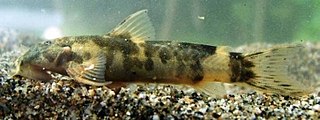
Joseph Nelson Rose was an American botanist. He was born in Union County, Indiana. His father died serving during the Civil War when Joseph Rose was a young boy. He later graduated from high school in Liberty, Indiana.

Trichogaster is a genus of gouramis native to South Asia from Pakistan to Myanmar. It is the only genus in the monotypic subfamily Trichogastrinae as set out in the 5th Edition of Fishes of the World, although that book states that there are two genera, the other being Colisa which is treated as a synonym of Trichogaster by Fishbase and the Catalog of Fishes. Fishbase also places the genus in the Luciocephalinae. Species of this genus are very popular in the aquarium trade.
The pink corydoras is a tropical freshwater fish belonging to the subfamily Corydoradinae of the family Callichthyidae. It originates in inland waters in South America, and is found in the Meta River basin in Colombia.

Astroblepus is a genus of fish in the family Astroblepidae found in South America and Panama. This genus is the only member of its family. These catfishes are primarily found in torrential streams in the Andean area. Astroblepus pholeter and A. riberae are troglobites adapted to living in subterranean water systems. These species are typically small, less than 10 cm (4 in). The largest species reaches 30 cm (1 ft). These fish have suckermouths like those of loricariids. They have two pairs of barbels, maxillary and nasal. The dorsal fin spine lacks a locking mechanism. These fish also have odontodes, tiny teeth on their skin. All species exhibit a conical, pointy type on their fin rays like that found in other loricarioids; other species also exhibit a blunt type that is only found on their skin.
Stathmonotus stahli, the eelgrass blenny or the seagrass blenny, is a species of chaenopsid blenny found in coral reefs in the western Atlantic ocean. It can reach a maximum length of 4 centimetres (1.6 in) TL. The specific name honours the Puerto Rican physician and biologist Agustín Stahl (1842-1917).
Basketweave cusk-eel is a fish species in the family Ophidiidae. It is widespread in the Eastern Pacific Ocean from Point Arguello in California, United States, to Baja California. The basketweave cusk-eel is a marine subtropical demersal fish that can be up to 28 centimetres (11 in) long. The specific name honours the journalist and philanthropist Ellen B. Scripps (1836-1932) one of the founders of the Scripps Research Institute.

Astroblepus chapmani is a species of catfish of the family Astroblepidae. It can be found in the Magdalena River in Colombia.
Astroblepus eigenmanni is a species of catfish of the family Astroblepidae. It can be found on Ecuador.
Astroblepus festae is a species of catfish of the family Astroblepidae. It can be found on south Ecuador.

Astroblepus grixalvii is a species of catfish of the family Astroblepidae. It can be found in Colombia and Ecuador.

Astroblepus guentheri is a carnivorous species of catfish of the family Astroblepidae. It can be found in rainforest streams in the basin of the Magdalena-Cauca rivers and in some Pacific slope rivers in Colombia. It is an uncommon and not well studied species.
Astroblepus mancoi is a species of catfish of the family Astroblepidae. It can be found on the Ucayali River on Peru.
Astroblepus mariae is a species of catfish of the family Astroblepidae. It can be found on the Meta River in Colombia and Venezuela.
Astroblepus nicefori is a species of catfish of the family Astroblepidae. It can be found of the Cauca River and the Magdalena River in Colombia.
Astroblepus phelpsi is a species of catfish of the family Astroblepidae. It can be found on Lake Maracaibo in Venezuela.
Astroblepus regani is a species of catfish of the family Astroblepidae. It can be found in Ecuador.
Astroblepus rengifoi is a species of catfish of the family Astroblepidae. It can be found on the Atrato River in Colombia.
Astroblepus riberae is a species of catfish of the family Astroblepidae. This cavefish is endemic to the Cajamarca region in Peru.
Astroblepus simonsii is a species of catfish of the family Astroblepidae. It can be found in Peru.

Corydoras agassizii is a species of catfish found in the Amazon basin. It can be found in the border area of Peru and Brazil. It lives in tropical waters with a water temperature of 22 - 26 °C, a pH of 6.0 - 8.0 and a hardness of 2 - 25 dH.






